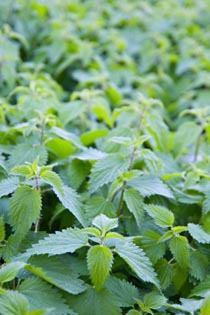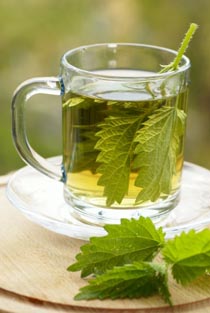It may take a bit of pluck to handle stinging nettle, but it’s worth the effort because the plant is packed with vitamins, iron and minerals and is as much at home in the kitchen as spinach. Nettle leaf is equally as impressive as a medicinal herb that improves many inflammatory conditions, such as allergies, joint pain, acne and eczema. Fortunately, you don’t have to wait for nettle leaf to be in season to get these benefits.

Nettle leaf, also known as stinging nettle, is a flowering perennial woodland herb native to North America, Europe, Asia and Africa, now naturalized in other temperate regions of the world. Its common name stems from the hair-like protrusions that grow out from the edges of the plant’s leaves. Technically known as trichomes, these hairy appendages are actually tiny stingers that, when brushed against, pierce the skin and deliver a dose of plant chemicals that include histamine, acetylcholine, serotonin and methanoic (formic) acid. The result is local paresthesia, a condition described as a “pins and needles” or burning sensation, as when your arm or leg “falls asleep.” Ironically, it is this very thing that makes stinging nettle an excellent medicinal herb. This feature also explains the various other descriptive common names for this plant, such as burn nettle, burn hazel and fire weed.
If anyone could speak volumes about the prickly nature of the nettle plant it would be Elisa, a fairy princess born of early 19th century Danish literature and resurrected by Hans Christian Andersen in the tale, “The Wild Swans.” In order to rescue her 11 brothers from a spell cast upon them by their evil stepmother that forced them to turn into swans at night, Elisa set out to spin shirts made from nettles that would restore the brothers to human form. Unfortunately, not only did our heroine suffer painful stings night after night from knitting nettles, her secretive behavior nearly caused her to be burned at the stake as a witch. Of course, as with many fairy tale endings, she was ultimately rewarded for her courage and lived happily ever after with her transformed brothers.
Another miraculous reference to nettles appears in “The Lacnunga,” the Anglo-Saxton collection of writings that included medical observations, prayers and mystical recitations dating to the 10th century. Among these pages exists the classic Nine Herbs Charm, a “remedy” for poisoning or infection of the blood invoked through nine herbs, old soap, apple juice and a beaten egg. As for the part of nettle, the healer “activated” the herb by chanting the following three times:
Nettle is this called; it dashes against venom,
It drives away cruel things, it casts out venom.
This is the herb that fought with the snake;
This is strong against venom, this is strong against infection,
This is strong against the Evil Thing that goes throughout the land.
Modern science shows that nettle leaf may indeed yield health-giving benefits without the need to invoke them with an incantation. The leaf contains compounds that suppress tumor necrosis factor-alpha (TNF-a) and other immune system chemicals that produce inflammation. Since this action is evident in the protective synovial tissue that surrounds the joints, stinging nettle has been used as a treatment for arthritis and rheumatism in Europe for years.
The bright yellow root and rhizome of the plant also produce pharmacological effects. The presence of campesterol, stigmasterol and beta-sitosterol, for instance, exert anti-inflammatory properties by disrupting the activity of certain enzymes that convert arachidonic acid obtained from eating animal fats into inflammation-producing compounds. This is why preparations from the root as well as the leaf are traditionally used to treat a wide range of inflammatory disorders, including arthritis, rheumatism, seasonal allergies, acne, psoriasis, eczema, dandruff and enlarged prostate associated with benign prostatic hyperplasia, or BPH.
Nettle also possesses antiviral properties and is sometimes used to counter kidney and urinary tract infections. According to the “Physicians’ Desk Reference for Herbal Medicines,” nettle root extracts halt the replication of the influenza A virus responsible for flu, as well as HIV-1 and HIV-2. However, it should be noted that nettle might increase the effects of diuretic medications, as well as diabetes and blood-thinning drugs.

Like many medicinal herbs, nettle also has a place at the table. The tender young leaves and stalks make a tasty vegetable or salad additive. In Europe, nettle soup is a traditional spring dish. A porridge made from nettles, water, flour and ground walnuts is served with fried eggs. The herb is also used to flavor certain cheeses, such as Gouda and a semi-hard cheese known as Yarg. The flavor of nettle is similar to spinach and the plant is equally nutritious with an abundance of iron, calcium, manganese, potassium and vitamins A, C and D. When harvesting nettle in spring, look for plants under a foot tall that have not yet flowered (older growth contains toxins that can potentially harm the kidneys). In addition, grasp the top part of the young plants firmly and snap the stalk to avoid brushing against the leaves, which will trigger the needle-like hairs to sting. As Aesop reminds us in the fable, “The Boy and the Nettle.” “Gently touch a nettle and it'll sting you for your pains; grasp it as a lad of mettle and soft as silk remains.” Of course, wearing gloves is also a good idea. Once cooked or steamed, the leaves completely lose their sting.
No fresh nettle afoot? Not a problem. Dried nettle leaf may also be taken as tea or added to soups, cheese and egg dishes, polenta, pesto and even spanakopita. In fact, we have a few recipes to keep you satisfied until Urtica dioica springs forth from the soil in the warmer months ahead.
Nettle Leaf Tea Recipe
See some of our other favorite Nettle Leaf Recipes